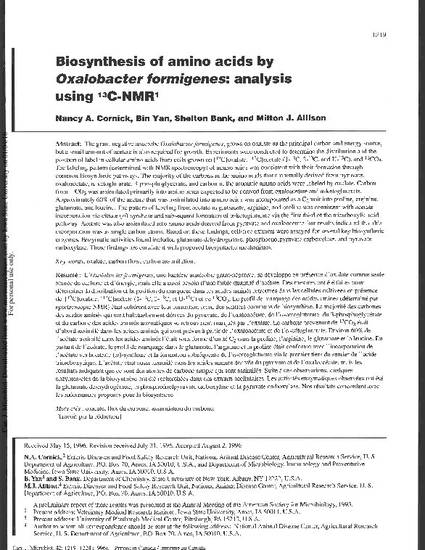
Article
Biosynthesis of amino acids by Oxalobacter formigenes: analysis using 13C-NMR
Canadian Journal of Microbiology
Document Type
Article
Disciplines
Publication Version
Published Version
Publication Date
12-1-1996
DOI
10.1139/m96-157
Abstract
The gram-negative anaerobe Oxalobacter formigenes, grows on oxalate as the principal carbon and energy source, but a small amount of acetate is also required for growth. Experiments were conducted to determine the distribution and the position of label in cellular amino acids from cells grown on [13C]oxalate, [13C]acetate (1-13C, 2-13C, and U-13C), and 13CCO3. The labeling pattern (determined with NMR spectroscopy) of amino acids was consistent with their formation through common biosynthetic pathways. The majority of the carbons in the amino acids that are usually derived from pyruvate, oxaloacetate, α-ketoglutarate, 3-phosphoglycerate, and carbon in the aromatic amino acids were labeled by oxalate. Carbon from 13CO3 was assimilated primarily into amino acids expected to be derived from oxaloacetate and α-ketoglutarate. Approximately 60% of the acetate that was assimilated into amino acids was incorporated as a C2 unit into proline, arginine, glutamate, and leucine. The pattern of labeling from acetate in glutamate, arginine, and proline was consistent with acetate incorporation via citrate (si)-synthase and subsequent formation of α-ketoglutarate via the first third of the tricarboxylic acid pathway. Acetate was also assimilated into amino acids derived from pyruvate and oxaloacetate, but results indicated that this incorporation was as single carbon atoms. Based on these findings, cell-free extracts were assayed for several key biosynthetic enzymes. Enzymatic activities found included glutamate dehydrogenase, phosphoenolpyruvate carboxylase, and pyruvate carboxylase. These findings are consistent with proposed biosynthetic mechanisms.
Rights
Works produced by employees of the U.S. Government as part of their official duties are not copyrighted within the U.S. The content of this document is not copyrighted.
Language
en
File Format
application/pdf
Citation Information
Nancy A. Cornick, Bin Yan, Shelton Bank and Milton J. Allison. "Biosynthesis of amino acids by Oxalobacter formigenes: analysis using 13C-NMR" Canadian Journal of Microbiology Vol. 42 Iss. 12 (1996) p. 1219 - 1224 Available at: http://works.bepress.com/nancy-cornick/5/

This article is from Canadian Journal of Microbiology 42 (1996): 1219, doi:10.1139/m96-157.